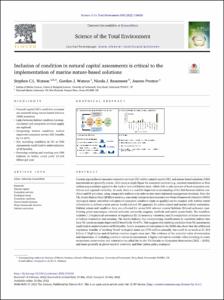| dc.contributor.author | Watson, Stephen C.L. | |
| dc.contributor.author | Watson, Gordon J. | |
| dc.contributor.author | Beaumont, Nicola J. | |
| dc.contributor.author | Preston, Joanne | |
| dc.coverage.spatial | Solent | en_US |
| dc.coverage.spatial | UK waters | en_US |
| dc.date.accessioned | 2023-02-02T14:45:21Z | |
| dc.date.available | 2023-02-02T14:45:21Z | |
| dc.date.issued | 2022 | |
| dc.identifier.citation | Watson, S.C.L., Watson, G.J., Beaumont, N.J. and Preston, J. (2022)
Inclusion of condition in natural capital assessments is critical to the implementation of marine nature-based solutions.
Science of the Total Environment, 838: 156026, 11pp. DOI: https://doi.org/10.1016/j.scitotenv.2022.156026 | en_US |
| dc.identifier.uri | https://repository.oceanbestpractices.org/handle/11329/2132 | |
| dc.description.abstract | Current approaches to measure ecosystem services (ES) within natural capital (NC) and nature-based solutions (NbS)
assessments are generally coarse, often using a single figure for ecosystem services (e.g., nutrient remediation or blue
carbon sequestration) applied to the local or national habitat stock, which fails to take account of local ecosystem conditions
and regional variability. As such, there is a need for improved understanding of the link between habitat condition
and ES provision, using comparable indicators in order to take more informed management decisions. Here the
UK, Solent Marine Sites (SEMS) is used as a case study system to demonstrate how Water Framework Directive (WFD)
‘ecological status’ and other indicators of ecosystem condition (state or quality) can be coupled with habitat extent
information to deliver a more precise locally-tailored NC approach for active coastal and marine habitat restoration.
Habitat extent and condition data are collected for seven NbS relevant coastal habitats (littoral sediment, matforming
green macroalgae, subtidal sediment, saltmarsh, seagrass, reedbeds and native oyster beds). The workflow
includes: 1) biophysical assessment of regulatory ES; 2) monetary valuation; and 3) compilation of future scenarios
of habitat restoration and creation. The results indicate that incorporating classifications by condition indices into
local NC extent accounts improved ES benefits by 11–67%. This suggests that omitting condition from NC assessments
could lead to undervaluation of ES benefits. Future scenarios of restoration in the SEMS also show that the additional
regulatory benefits of reaching ‘Good’ ecological status are £376 million annually, but could be as much as £1.218
billion if ‘High‘status and all habitat creation targets were met. This evidence of the potential value of restoration
and importance of including condition indices in assessments is highly relevant to consider when investing in water
ecosystems conservation and restoration as called for by the UN Decade on Ecosystem Restoration (2021−2030),
and more generally in global nutrient neutrality and blue carbon policy strategies. | en_US |
| dc.language.iso | en | en_US |
| dc.rights | Attribution 4.0 International | * |
| dc.rights.uri | http://creativecommons.org/licenses/by/4.0/ | * |
| dc.subject.other | Solent Marine Sites (SEMS) | en_US |
| dc.subject.other | Ecosystem services | en_US |
| dc.subject.other | Ecological status | en_US |
| dc.subject.other | Ecosystem condition | en_US |
| dc.subject.other | Nature-based solutions | en_US |
| dc.subject.other | Water framework directive | en_US |
| dc.subject.other | Habitat restoration | en_US |
| dc.subject.other | Natural capital | en_US |
| dc.title | Inclusion of condition in natural capital assessments is critical to the implementation of marine nature-based solutions. | en_US |
| dc.type | Journal Contribution | en_US |
| dc.description.refereed | Refereed | en_US |
| dc.format.pagerange | 11pp. | en_US |
| dc.identifier.doi | http://dx.doi.org/10.1016/j.scitotenv.2022.156026 | |
| dc.subject.parameterDiscipline | Human activity | en_US |
| dc.bibliographicCitation.title | Science of the Total Environment | en_US |
| dc.bibliographicCitation.volume | 838 | en_US |
| dc.bibliographicCitation.issue | Article 156026 | en_US |
| dc.description.sdg | 14.a | en_US |
| dc.description.maturitylevel | Pilot or Demonstrated | en_US |
| dc.description.methodologyType | Reports with methodological relevance | en_US |
| obps.contact.contactname | Stephen C.L. Watson | |
| obps.contact.contactemail | stw@pml.ac.uk | |
| obps.resourceurl.publisher | https://www.sciencedirect.com/science/article/pii/S0048969722031230?via%3Dihub | |
 Repository of community practices in Ocean Research, Applications and Data/Information Management
Repository of community practices in Ocean Research, Applications and Data/Information Management

